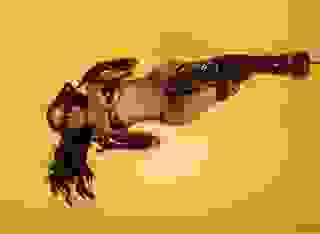- Romance
- Small Boats and Brave Men
Note: You can change font size, font face, and turn on dark mode by clicking the "A" icon tab in the Story Info Box.
You can temporarily switch back to a Classic Literotica® experience during our ongoing public Beta testing. Please consider leaving feedback on issues you experience or suggest improvements.
Click hereHaving grown up in Southeast Florida, the city of Fort Lauderdale to be more specific, I have always been around boats.
My dad served in the Pacific during World War II. During a voyage from Norfolk, Virginia through the Panama Canal and onward to San Diego in 1942 his ship put in to Port Everglades to re-fuel. During a brief liberty he visited Fort Lauderdale.
The town made an impression on him so much that when the war was over he and my mother moved there in 1948 with me and my younger sister, Barbara. My name is Eric Mueller.
Dad got a job at Broward Marine, a ship building facility on the New River, which had a contract to build mine sweepers for the Dutch Navy. Pop was a motor machinist in the Navy during the war and had an extensive knowledge of diesel engines.
When the last of the ships was completed in 1952, he remained with the company that had by now shifted to building yachts; some as large as sixty-five and seventy feet.
In 1957 dad and two of his friends decided to open their own boat yard. They saw the boating boom that was beginning in South Florida and thought they could fill a niche not being met by the larger boatyards. They started out building smaller, less expensive boats, in the sixteen to twenty-five foot range. Over the years dad bought out his two partners and became the sole owner of the boatyard.
By the time I was entering high school the business had expanded to such an extent that he now employed over thirty craftsmen.
When I was in my mid-teens dad gave me a job at his boatyard working during the summers and during breaks from school. The first summer I worked there I was one of the go-for guys you know . . . . 'Eric go for a box of stainless steel screws for me . . . Eric go for a three-eights inch drill and please bring me a fifty foot extension cord . . . Eric bring me another gallon of fiberglas resin. You get the [picture.
I learned a lot just by watching these skilled craftsmen that first summer. I continued working there every summer and afternoons at the end of the school day all through high school and during breaks from school when I was away at college.
When I graduated from high school I applied to the University of Florida and was accepted. Four years later, in 1968, I graduated with a Bachelor's Degree in Mechanical Engineering and a minor in Marine Engineering.
My social life in both high school and college was great. I had no trouble finding girl friends. My only problem was finding a girl with which I would want to spend the rest of my life.
There was one girl that I met during my Freshman year at Florida. Her name was Elizabeth Becker and I really, really cared for her and I wanted to get to know her a whole lot better. I knew she felt the same way toward me.
At the end of the school year I went home to South Florida and she went home to North Carolina. We did keep in touch over the summer by letter and the occasional long distance phone call.
In early August she wrote, that because if a family problem, she wouldn't be returning to school for the Fall Semester.
I wrote back asking what had happened. The letter came back stamped 'Moved/Left No Forwarding Address'. When I tried calling I received the following message. The number you have dialed 555-555-5555 is no longer in service.
After several other failed attempts to contact her we lost touch with one another.
In June of 1968, after graduation, I wanted to continue on for a Masters Degree but my Draft Board said 'No'. I had run out of student deferments when I received my Bachelor's Degree. Even though I had a fairly high draft number I decided to visit the Navy Recruitment Office.
The recruiter took one look at my qualifications and offered me the opportunity to attend Officer Candidate School (OCS). I signed on the dotted line and committed myself for at least the next five years of my life.
Six months later I was a newly commissioned Ensign in the United States Navy. Somewhere along the line the Navy had discovered my experience working in my dad's boatyard and I received an assignment to PCFs (Patrol Craft, Fast) otherwise known as Swift Boats and was sent to Coronado, California for training.
These boats were all-aluminum, fifty foot long, shallow-draft vessels operated by the Navy. They were used to patrol coastal areas and later for work on interior waterways as part of what was known as the 'brown-water navy'. During the Viet Nam War they were used to halt the Vietcong movement of arms and munitions, insert SEAL teams for counter-insurgency operations or to transport Vietnamese forces.
After completing my training I was sent to South Vietnam to join up with a detachment already in place at a base in the Mekong Delta region.
I was placed in command of PCF-35 with a crew of five, a Bosun's Mate, a radarman, an engineer, along with a Quartermaster and Gunner's Mate. The latter two operated the twin .50 caliber M2 Browning machine guns in a turret above the pilot house, an over-and-under .50-caliber machine gun as well as an 81mm mortar combination mounted on the rear deck. In late 1969 my crew was supplemented with the addition of a Vietnamese trainee.
PCF-35, a Mark III boat, was powered by a pair of General Motors Detroit marine diesel engines rated at 480 horsepower each, with a design range of 320 nautical miles at twenty-one knots (25 mph) with a top speed of twenty-five knots (30 mph).
Our primary mission was to patrol the Mekong Delta area which was composed of over ten thousand square miles of marshland, swamps and forested areas all interlaced by rivers and canals controlled by the Vietcong with some support from North Vietnamese regulars. We also would be performing special operations which included gunfire support, troop insertion and evacuation, and raids into enemy territory.
It soon became very clear to me that control of the waterways was being hotly contested by the Vietcong. They had developed a number of tactics to challenge us. They set up ambushes, built obstructions in the canals to create choke points, and began to place mines in the waterways.
Coming back down river was always more dangerous then going up river. The passage of our patrol assured the Vietcong we would be returning at some point and provided them the opportunity to ambush us. It was on one of these occasions, about six months after my arrival that, as we were returning from a mission, we were attacked.
I was hit by a stray round from an AK-47 in my upper left shoulder. Fortunately, it was a through and through and caused no significant damage.
Unfortunately, it was not severe enough to earn me a ticket home. It did earn me a Purple Heart and thirty days recuperating in a naval hospital in Yokohama, Japan.
Upon my return to the unit I met Ensign James Kerr for the first time. He was a real piece of work. He came from a family of considerable wealth and influence which he all too often pointed out to us.
I don't think he liked me. I was senior to him by about ninety days, had combat experience and was well-liked by my crew. My philosophy was my men depended on me to get them home alive and I depended on them for the same thing. I know I had their respect. I had earned it
Kerr on the other hand treated his crew with disdain and considered them below his station in life. On more than one occasion he opined that he could hardly wait until his father could pull some strings and get him the hell out of there.
After several missions I began hearing some disturbing scuttlebutt concerning Ensign Kerr. Seems like every time his boat came under enemy fire he disappeared below deck and didn't re-emerge until the shooting had stopped. He soon became known as 'Chicken-Shit Kerr' amongst the enlisted personnel.
Sure enough a little more than six weeks after his arrival he was gone. Transferred back to the states for some obscure reason. Good riddance. Officers like him were sure to get someone killed.
I spent a year in Vietnam and in 1970 I was scheduled to rotate home but I felt I needed to stay so I volunteered for another tour.
******************
In late October 1971 our entire unit was withdrawn and shipped home. For an early Christmas present I was promoted to Lieutenant. I had already received a promotion from Ensign to Lieutenant j.g. early during my second tour in Nam. Promotions came quickly during wartime.
I got to spend the Christmas Holidays with my family before reporting to my next duty station at Mare Island, training crews for PBRs (Patrol Boat, Rivers) 32-foot long all fiberglass boats with twin water jet propulsion as well as the PCF Swift Boats.
It was a great duty station right outside of San Francisco. Many a weekend night my buddies and I would hit the bars and clubs down by the bay. It was one of those nights that I met Deloris Collins. She was with a bunch of her girl friends celebrating someone's birthday. My buddy, Dave another officer I had served with in Nam, knew one of the girls and we were soon invited to join them.
To make a long story short Deloris and I hit it off and we spent the next several months dating one another. I was really falling hard for her when one night at a club we frequented James Kerr showed up. He was still in the service, still only a Lieutenant j.g., serving as an admin aide in one of the many offices at Mare Island.
Seeing Deloris and I seated at a table he barged over, sat down and introduced himself as one of my long lost buddies from Nam. He was so full of crap his eyes were brown. I went to refresh Deloris and my drinks from the bar and when I returned found that he had dragged her onto the small dance floor.
After the second dance I got up, walked over and cut in saying "Do you mind if I dance with 'MY' date." He gave me a snarky look as he stepped away, relinquishing Deloris to me.
On our way taking her home that evening she asked me about him. I gave her the G-rated version of his activities while we were serving together in Viet Nam. In hindsight I should have been a lot more descriptive and given her the R-rated version.
The following weekend I had the duty and couldn't leave the base. When I called Deloris, she was disappointed but told me she understood and would see me the following Friday night.
When I showed up at her parents home I was met at the door by her mother. "Eric, why are you here? Didn't Deloris tell you she wouldn't be home tonight?"
Thinking there might have been a SNAFU in our communications I headed down to Fishermen's Wharf by myself. As I walked into one of the many bars, low and behold, what do I see but Deloris and James Kerr playing kissy face in one of the secluded booths.
When I walked over to them Deloris looked up with an 'Oh My God' look on her face and Kerr with a shit-eating grin on his.
All I said was, "have a great evening, Deloris. I won't be calling or seeing you anymore."
Then I just turned and walked away. No point in getting into something with him. He just wasn't worth my career and it appeared neither was she.
I heard a couple of months later from Dave that his girl friend had told him that Kerr knocked Deloris up and then dumped her.
Kerr's parents stepped in and had bought her off to the tune of twenty grand to keep her mouth shut and move on with her life without him.
One night, Deloris's brother, George looked me up and filled me in on the entire story. I had always liked George. He had also served in Vietnam the same time I was there. But since he was in the army we never ran across each other. However, we did share a special camaraderie having served together in that hell-hole.
George told me when Kerr found out Deloris was pregnant he left her high and dry. Told her could never marry anyone so far below 'his' station in life.
After Kerr's parents had given the money to Deloris, she suffered a miscarriage and lost her baby. When Kerr found out about this he showed up wanting her to return 'His' money.
"Dad and I threw him out on his ass."
Mysteriously, shortly thereafter, Kerr was transferred to somewhere on the east coast.
George told me he paid Kerr a little visit late one night just before good old James was set to leave San Francisco. At the conclusion of their little discussion, which included some comments regarding his questionable parentage, Kerr spent the next four weeks in the base hospital. Seems that he had to recover from a brutal beating by person or persons unknown. Too bad. Couldn't have happened to a nicer guy.
******************
I spent the next two years at Mare Island involved with the training of new crews to man the PBRs and the PCF Swift Boats. I was promoted to Lieutenant Commander in July of 1975. During the time I spent there I dated a lot of different girls over those years but never found another one like Deloris.
One afternoon in September of 1975 I happen to glance at an official Navy document soliciting applications for the command position to head the Naval Surface Warfare Center Facility located in Fort Lauderdale, Florida at Port Everglades. What caught my eye was the location. It was where I grew up and my where my parents were still living.
I don't want to take the time to paraphrase the entire document it so I am going to post the official publication verbatim just as I received it.
***************************************************************************************************************************************************************************************************
FORT LAUDERDALE BRANCH
Naval Surface Warfare Center
The United States Navy established the Fort Lauderdale facility in 1952 to support the underwater mine warfare program. Through the years, Branch personnel have kept pace with the diverse and complex testing techniques required by today's advanced weapon systems and components. Working in close partnership with the Navy's operating forces, the Branch plans and supports test programs in a variety of warfare areas for NSWC as well as for other military and civilian government activities and their contractors. The Fort Lauderdale detachment is headed by a military officer in overall command and a civilian facility manager. The experienced staff represents many years of T&E expertise.
The administrative complex and shore support facilities of the Branch are adjacent to the Fort Lauderdale-Hollywood International Airport, about one mile south of Florida Route 84 and one mile west of U.S. Route 1.
The range house and boats are located at the south jetty of the Port Everglades ship channel. This is an area from which it is possible to interface with naval and air units under ideal conditions for testing interoperable weapons and communications systems. The area's superb environmental and physical characteristics offer a rare combination of technical, environmental, and logistic advantages such as:
* Open ocean and unrestricted waters
* Hard sandy ocean bottom and clear water, facilitating recovery of test hardware
* Realistic operational environment
* Sheltered harbor with controlling depth of 45 feet in the slips and 44 feet in the turning basin
* Air lanes sufficiently free to permit airdrops
* Excellent climate suitable for year-round test operations
* Proximity to Navy and Air Force activities and contract support
* Convenient to road, air, rail, and sea transportation
services
The Fort Lauderdale Branch of the Naval Surface Warfare Center operates the only land-based, deep-water test and evaluation (T&E) facility located on the Eastern Seaboard. Here, NSWC and other research and development activities conduct full-scale trials of air, surface, and underwater weapon systems under a variety of oceanographic conditions.
As the Navy's principal research, development, test and evaluation center for surface ship weapons systems, ordnance, mines, and strategic systems support, NSWC relies upon its Fort Lauderdale Branch to support rigorous field trials in conditions comparable to the actual operating environment. The Atlantic Ocean test range features a deep-water cable monitoring system, a shore tracking
system, and underwater and surface communications and tracking systems. The facility's experienced technical staff, excellent shore facilities, and waterborne craft combine to offer an unparalleled environment for year-round T&E operations.
The center conducts field trials of air, surface, and underwater ordnance systems in the Atlantic Ocean in addition to:
* Recovering test hardware in depths to 2000 feet
* Developing, installing, maintaining, and operating ship tracking and offshore positioning equipment
* Installing and maintaining a deep-water cable monitoring system
* Providing weapon assembly and storage areas, technical and support personnel, security, shore tracking and monitoring stations, boats and utility craft to support field trials
Water depths in the test area range from 500 feet three miles offshore down to 2000 feet only 21.5 miles out. The continental shelf drops off in the test range at its closet point to the U.S. mainland, enabling the Fort Lauderdale Branch to operate the only T&E facility with deep water so close to shore. Tides vary from 0.6 to 3.7 feet except during unusual storm situations.
Ocean currents on the test ranges typically run between 0.5 and 3.0 knots, with a maximum of 4.5 knots. A mile or two from shore, the Gulf Stream offers a rigorous environment for underwater testing, while inshore eddies and spring tides offer a variety of currents for environmental studies.
Water salinity in the Atlantic Ocean test ranges measures approximately 35.7 parts per 1000.
The climate and water conditions are suitable for at-sea operations an average of 351 days of the year. The warm, clear waters are conducive to underwater photography, video coverage of operations, and recovery of test hardware. Trials may be conducted in deep waters with either a sandy bottom or a rocky bottom, as appropriate. The proximity to ship traffic provides realistic at-sea operational conditions.
Tracking, ranging, and plotting are the principal functions conducted on NSWC's extensive Atlantic Ocean test ranges in conjunction with airdrops and the ranging of surface ships and submerged submarines. A system of 375 miles of underwater cables monitors the performance of test hardware at depths down to 2000 feet. Underwater cable types include multi-conductor, coaxial, and fiberoptic. Each range may be equipped with underwater tracking systems and telephones. The Fort Lauderdale Branch arranges to lay additional cables to meet test program requirements of user activities.
The Fort Lauderdale Center also tests and evaluates a variety of ordnance. surface, and underwater systems in water depths from 1 to 2000 feet. Typical operations involve:
* Underwater ordnance deployment, ranging, and recovery
* Tactical ships' data
* Autonomous vehicle tracking
* Mine countermeasures
* Trajectory and water-entry performance
* Submerged ordnance hardware
The Fort Lauderdale Branch operates various marine facilities from its site on the Port Everglades main ship channel.
The facility's small craft-including work, utility, and dive boats are berthed at the south jetty of the channel. Three cement piers, 41 feet long by 51/2 feet wide, with water depth of 10 feet, accommodate small craft up to a maximum of 75 feet.
A large, open area adjacent to the piers is convenient for loading and unloading craft, reeling and splicing cables, and as a general work area. A two-story building serves as a combination assembly area, office, and stowage area for auxiliary support equipment.
Navy diving teams are attached full time to the facility are trained and experienced in underwater recovery operations. Most diving operations occur in less than 120 feet of water using conventional scuba gear. The divers also perform underwater inspection and repair of Navy ships and submarines at Port Everglades.







